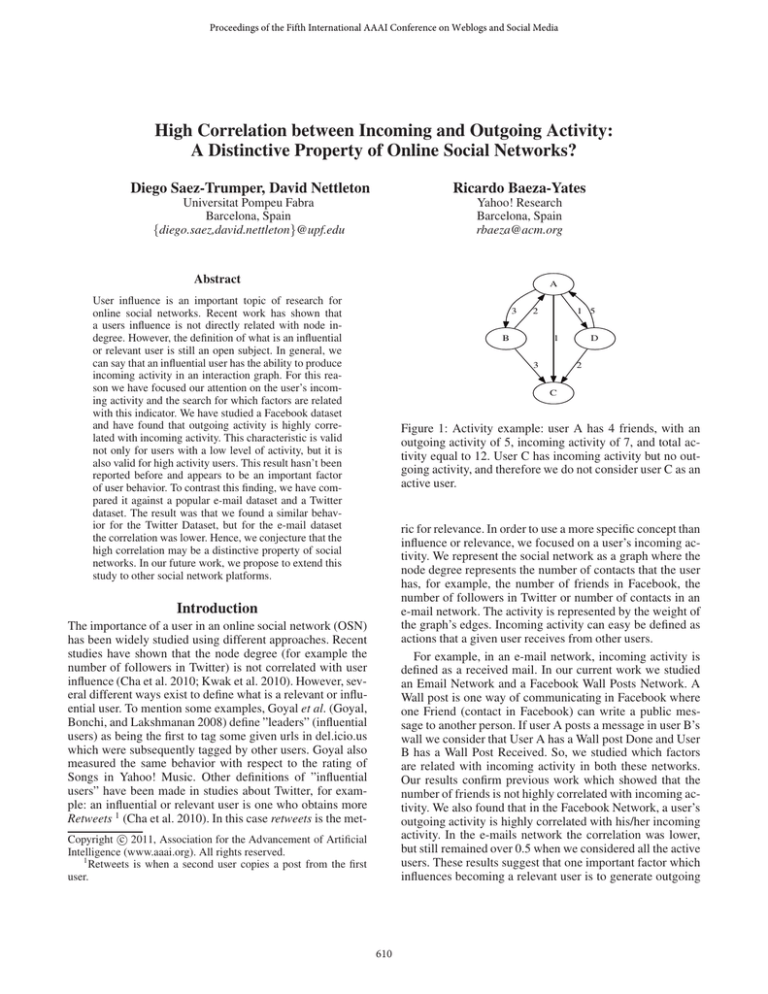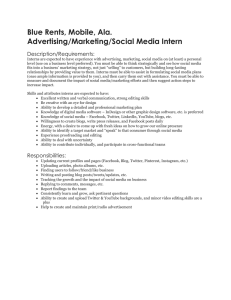
Proceedings of the Fifth International AAAI Conference on Weblogs and Social Media
High Correlation between Incoming and Outgoing Activity:
A Distinctive Property of Online Social Networks?
Diego Saez-Trumper, David Nettleton
Ricardo Baeza-Yates
Universitat Pompeu Fabra
Barcelona, Spain
{diego.saez,david.nettleton}@upf.edu
Yahoo! Research
Barcelona, Spain
rbaeza@acm.org
Abstract
A
User influence is an important topic of research for
online social networks. Recent work has shown that
a users influence is not directly related with node indegree. However, the definition of what is an influential
or relevant user is still an open subject. In general, we
can say that an influential user has the ability to produce
incoming activity in an interaction graph. For this reason we have focused our attention on the user’s incoming activity and the search for which factors are related
with this indicator. We have studied a Facebook dataset
and have found that outgoing activity is highly correlated with incoming activity. This characteristic is valid
not only for users with a low level of activity, but it is
also valid for high activity users. This result hasn’t been
reported before and appears to be an important factor
of user behavior. To contrast this finding, we have compared it against a popular e-mail dataset and a Twitter
dataset. The result was that we found a similar behavior for the Twitter Dataset, but for the e-mail dataset
the correlation was lower. Hence, we conjecture that the
high correlation may be a distinctive property of social
networks. In our future work, we propose to extend this
study to other social network platforms.
3
2
B
1 5
1
3
D
2
C
Figure 1: Activity example: user A has 4 friends, with an
outgoing activity of 5, incoming activity of 7, and total activity equal to 12. User C has incoming activity but no outgoing activity, and therefore we do not consider user C as an
active user.
ric for relevance. In order to use a more specific concept than
influence or relevance, we focused on a user’s incoming activity. We represent the social network as a graph where the
node degree represents the number of contacts that the user
has, for example, the number of friends in Facebook, the
number of followers in Twitter or number of contacts in an
e-mail network. The activity is represented by the weight of
the graph’s edges. Incoming activity can easy be defined as
actions that a given user receives from other users.
For example, in an e-mail network, incoming activity is
defined as a received mail. In our current work we studied
an Email Network and a Facebook Wall Posts Network. A
Wall post is one way of communicating in Facebook where
one Friend (contact in Facebook) can write a public message to another person. If user A posts a message in user B’s
wall we consider that User A has a Wall post Done and User
B has a Wall Post Received. So, we studied which factors
are related with incoming activity in both these networks.
Our results confirm previous work which showed that the
number of friends is not highly correlated with incoming activity. We also found that in the Facebook Network, a user’s
outgoing activity is highly correlated with his/her incoming
activity. In the e-mails network the correlation was lower,
but still remained over 0.5 when we considered all the active
users. These results suggest that one important factor which
influences becoming a relevant user is to generate outgoing
Introduction
The importance of a user in an online social network (OSN)
has been widely studied using different approaches. Recent
studies have shown that the node degree (for example the
number of followers in Twitter) is not correlated with user
influence (Cha et al. 2010; Kwak et al. 2010). However, several different ways exist to define what is a relevant or influential user. To mention some examples, Goyal et al. (Goyal,
Bonchi, and Lakshmanan 2008) define ”leaders” (influential
users) as being the first to tag some given urls in del.icio.us
which were subsequently tagged by other users. Goyal also
measured the same behavior with respect to the rating of
Songs in Yahoo! Music. Other definitions of ”influential
users” have been made in studies about Twitter, for example: an influential or relevant user is one who obtains more
Retweets 1 (Cha et al. 2010). In this case retweets is the metc 2011, Association for the Advancement of Artificial
Copyright Intelligence (www.aaai.org). All rights reserved.
1
Retweets is when a second user copies a post from the first
user.
610
Dataset
Enron
Facebook
Twitter
activity. We also extended this analysis to a Twitter sample. As mentioned before, previous work showed that there
is very little correlation between Followers and Mentions,
therefore we decided to take another approach considering
the number of updates (micro-post) as an outgoing activity, and trying with two different kinds of incoming activity:
the number of replies and the number of followers. Our results show that the group of users with most updates usually
has more replies and followers than users with a low level
of outgoing activity. However, these results are preliminary
and need to be tested with other datasets, adding new and
more complex parameters that consider, for example, temporal analysis.
Users
11,254
34,277
136,662
Activity
1,277,214 emails
836,576 wall posts
54,764,095 tweets
Table 1: Summary of datasets used.
Experiments
We are interested in finding factors related with incoming
activity. Related work shows that a relation does not exist
between node degree in the social graph (friends, followers, etc) and the incoming activity (Cha et al. 2010) (wall
posts received, mentions, etc). For this reason, we have focused our attention on the relation between incoming activity and outgoing activity, the latter in our case, corresponding to ”wall posts done”. In other words, we compare the
out-degree and in-degree of nodes, taking into consideration
the weight of the edge. In the case of the Facebook and Email datasets, we have compared the same kind of outgoing and incoming activity. That is, we compare posts done
versus posts received and mails sent versus mails received,
respectively. Then we apply a simple correlation parameter.
In the case of Twitter, the nature of the outgoing (micropost) and the incoming activity (followers) is different. In
this case, we group users by their level of activity and then
we compare them.
Datasets
We have used three different datasets, summarizing their
characteristics in Table 1, as follows:
Enron’s Emails Enron’s e-mails dataset it is a well known
dataset. From the version that we obtained (Shetty and Adibi
2005) we processed information from 250,483 users.We
consider each unique e-mail address as an user. Because we
are interested in active users we filtered considering only
users that have at least one e-mail sent and one e-mail received. Applying this filter we obtained 11,254 active users.
Facebook Wall Posts The dataset used corresponds to
New Orleans Facebook’s Regional Network2 (Viswanath
et al. 2009) containing information about 58016 different
users, who have been anonymized. Specifically we have two
lists, one containing user-to-user links (Friends), and a second list with user-to-user Wall Posts, most of them with a
third column containing a Timestamp. The information covers a time-span from September 2006 to January 2009. From
these lists we can obtain the number of friends for each user
and his/her outgoing and incoming activity. Because we are
interested in users interaction we only consider users that
have at least one Wall Post done and one Wall Post Received,
defined as “active users”. Applying this filter we obtained
34,277 active users.
Facebook and Emails Analysis
The results in Table 2 confirm previous work in the literature which demonstrates that a strong correlation does not
exist between the number of friends and the number of posts
received. However, the correlation between posts done and
posts received appears very strong (0.91) in the Facebook
dataset. We recalculated the correlation coefficients against
the users activity, in order to test if the correlations hold true
when we remove the less active users. In Figure 2 we can
observe that the correlation remains over 0.90 for 90 percent of the users (users whose activity is below 200 actions),
and remain strong (over 0.70), if we consider only the most
active users.
In the e-mail dataset, the correlation will depend of how
we compute e-mails carbon copies ”CC:”3 for the outgoing
activity. Suppose that user A sent an e-mail to user B with
copies to users C and D. To compute user A outgoing activity we can consider that (a) she have 3 outgoing-actions,
one per recipient, or we can consider (b) only 1 action, one
per sent mail. In the first case, the correlation between outgoing and incoming activity results low (see Figure 2). In
the second case, the correlation is higher, starting from 0.69
and remaining over 0.5 for the most active users (see Figure 3). However, this correlation is significant lower than in
the Facebook graph.
Twitter In Twitter every user has a unique ID. Users information can be accessed by the Twitter API (Benevenuto
et al. 2010) using this ID. We randomly selected 250,000
numbers between 0 an 150,000,000 being able to download
approximately 55% of these ids, corresponding to 136,662
users. The information about users contains, among other
things, their number of Tweets (statuses), followers, friends
(also called followees), profile age (date of profile creation)
and if there exists a URL associated to the profile. We also
downloaded the last 200 tweets from each user.
Our dataset is consistent with similar and more detailed
studies of Twitter (Kwak et al. 2010), which have demonstrated power law distributions for user’s followers and
friends. The time of the profile creation (profile’s age) covers June 2006 to July 2010, the number of followers ranges
from 0 to over 600,000 and the number of tweets from 0 to
over 300,000 per user.
2
Regional Networks has been deprecated by Facebook since
August 2009
3
Note that we use ”CC:” for e-mails copies and CC for Clustering Coefficient.
611
1
1
Correlation between e−mails wall post done and received
% Active Users
0.9
0.9
0.8
0.8
0.7
0.7
0.6
0.6
% Percent
% Percent
Correlation between e−mails wall post done and received
% Active Users
0.5
0.4
0.5
0.4
0.3
0.3
0.2
0.2
0.1
0.1
0
0
100
200
300
400
500
600
700
800
900
0
1000
Total User Activity (Done + Received)
Num. F.
1
-0.11
0.47
0.43
CC.
-0.11
1
-0.11
-0.11
P. Re.
0.47
-0.11
1
0.91
100
200
300
400
500
600
700
800
900
1000
Total User Activity (Done + Received)
Figure 2: Enron’s e-mails with Carbon Copy(a): Correlation
between out-going (e-mail’s sent) and incoming (e-mails received) compared with users total activity. The correlation is
under 0.5 if we consider the top 50 percent of most active
users.
Variable
Number of Friends
Clustering Coeff.
Posts Received
Posts Done
0
Figure 3: Enron’s e-mails without Carbon Copy (b): Using
this configuration the correlation increase, going over 0.6.
This correlation is significant, but is lower than in Facebook
Dataset
active users) and created an stratified sub-sample, selecting
randomly 2,000 users for each category. Next, we estimate
the number of replies for these 10,000 users. We found that
around the 80% of users does not have at least one mention,
and only the 5% users have over 15 replies. Moreover, in the
3 categories with lowest outgoing activity (that is users with
300 post or less) only the 10% users have at least one reply. Users in the most active groups (category 4 and 5), over
300 and 1200 post, has 22% and 47% of users with at least
one reply. However, an small fraction of users have at least
15 replies, and they are concentrated in the category of most
active users (see Table 3. The small number of replies does
not allow to make conclusions, but we can see that there exists a relation between outgoing activity and Twitter replies.
P. D.
0.43
-0.11
0.91
1
Table 2: Facebook’s Correlation Matrix.
Twitter Analysis
In this section, we consider two different kinds of incoming
activity: first we have used the number of replies, meaning
that user A gets one reply when user B posts with the prefix
@A. This is a standard in Twitter, and intuitively is similar
to the e-mail reply we used in previous section. However,
we repeated our study considering the number of followers
as an incoming activity. We have use followers as outgoing
activity for three reasons: firstly, as we mentioned before,
in the literature there are authors who have already studied different kinds of incoming activity such as Retweets
or Mentions, secondly because this information (the number
of followers and updates) is public and can be obtained directly from the Twitter statistics, avoiding any type of noise
or errors, and thirdly because we consider that obtaining followers could be considered as an important goal for Twitter
users, moreover, previous work has consider the relation between number of post and followers to construct influence
rankings (Weng et al. 2010).
We started studying the relation between post an replies.
The number of replies for each user is not contained in the
information given by Twitter API. Therefore, was necessary
to use the Twitter Search API to try to estimate this number. To face this challenge, we divided our sample by outgoing activity level (number of post) in five categories(where
category 1 are inactive users and category 5 are the very
Outgoing Activity
Very Low
Low
Medium
High
Very High
Over 1 reply
0%
2%
7%
19%
48%
Over 15 replies
0%
0%
1%
9%
17%
Table 3: Twitter: Percent of users with replies (incoming activity)
The information about the number of followers is provided by the Twitter, then we can work with our sample of
136,662 users. We have divided our sample in 5 bins using a equal frequency discretization for each feature. In this
way, each user can be defined as an instance with two features, thus: U(outgoing,incoming). Considering that we have
5 possible values for each feature, it is possible to have 25
different types of users. As an example, a user type T could
be characterized by a low outgoing activity and a very high
incoming activity. Figure 4 shows that when the level of out-
612
necessary to confirm them comparing with other datasets. It
is also important to analyze the dynamic behavior of users,
considering the time that they use to perform their actions.
It is reasonable to think that the results obtained will change
if a high activity is concentrated over a short time span which could indicate spammer behavior- compared with an
user whose activity is periodical and more spread over time.
In our future work we will analyze this temporal behavior
and its implication for incoming activity.
References
Benevenuto, F.; Magno, G.; Rodrigues, T.; and Almeida, V.
2010. Detecting spammers on twitter. In Proceedings of
the 7th Annual Collaboration, Electronic messaging, AntiAbuse and Spam Conference (CEAS).
Cha, M.; Haddadi, H.; Benevenuto, F.; and Gummadi, K. P.
2010. Measuring user influence in twitter: The million follower fallacy. In in ICWSM 10: Proceedings of international
AAAI Conference on Weblogs and Social.
Goyal, A.; Bonchi, F.; and Lakshmanan, L. V. S. 2008. Discovering leaders from community actions. In CIKM ’08:
Proceeding of the 17th ACM conference on Information and
knowledge management, 499–508. New York, NY, USA:
ACM.
Kwak, H.; Lee, C.; Park, H.; and Moon, S. 2010. What is
Twitter, a Social Network or a News Media? In World Wide
Web Conference. ACM Press.
Shetty, J., and Adibi, J. 2005. Discovering important nodes
through graph entropy the case of enron email database. In
Proceedings of the 3rd international workshop on Link discovery, LinkKDD ’05, 74–81. New York, NY, USA: ACM.
Viswanath, B.; Mislove, A.; Cha, M.; and Gummadi, K. P.
2009. On the evolution of user interaction in facebook. In
Proceedings of the 2nd ACM SIGCOMM Workshop on Social Networks (WOSN’09).
Weng, J.; Lim, E.-P.; Jiang, J.; and He, Q. 2010. Twitterrank:
finding topic-sensitive influential twitterers. In Proceedings
of the third ACM international conference on Web search
and data mining, WSDM ’10, 261–270. New York, NY,
USA: ACM.
Figure 4: Twitter: Relation of Followers and Number of
Posts. On the x-axis we have divided users by their number of followers (incoming activity), and on the y-axis we
show the number of users with different levels of post activity (outgoing).
going activity increases, incoming activity also increases. As
a consequence, users with a high number of followers have
the biggest number of post. With this simple analysis we
cannot infer which is the dependent variable, but is clear that
a relation exists.
Discussion and Future Work
We have found a strong correlation between outgoing and
incoming activity in the Facebook Dataset. Our analysis of
Twitter confirms this relation. The results for the e-mail
dataset shows that the correlation will depend of how outgoing activity is define. However, we have studied three different networks with different communications patterns: Facebook Wall posts has an one-to-one pattern, e-mails could
be consider as one to n pattern, and Twitter has a kind
of broadcast pattern, and all of them shows a this outgoing/incoming correlation . Moreover, the strong correlation
persists in Facebook users with a very high outgoing activity, and is also present for users with the same characteristics
in Twitter, suggesting that this relation could be a distinctive
property of Online Social Networks and Social Media.
However, these conclusions are preliminary and it will be
613




